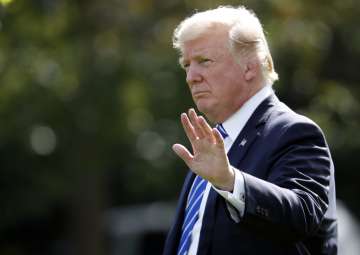Donald Trump to roll out new tax plan, heavy cut in taxes for individuals on cards
The public reveal of the plan was set for Wednesday. The day before, details emerged on Capitol Hill while Trump personally appealed to House Republicans and Democrats at the White House to get behind his proposal.

US President Donald Trump and Congressional Republicans are rolling out a wide-ranging plan to cut taxes for individuals and corporations, simplify the tax system, and likely double the standard deduction used by most Americans. Months in the making, the plan meets a political imperative for Republicans to deliver an overhaul of the US tax code after the failure of the health care repeal.
The public reveal of the plan was set for Wednesday. The day before, details emerged on Capitol Hill while Trump personally appealed to House Republicans and Democrats at the White House to get behind his proposal.
“We will cut taxes tremendously for the middle class. Not just a little bit but tremendously,” Trump said as he met with members of the tax-writing Ways and Means Committee. He predicted jobs “will be coming back in because we have a non-competitive tax structure right now and we’re going to go super competitive.”
Among the details: repeal of the tax on multimillion-dollar estates, a steep reduction in the rate corporations pay from 35 percent to 20 percent and potentially four tax brackets, down from the current seven. The current top rate for individuals, those earning more than $418,000 a year, is 39.6 percent.
The goal, the architects say, is a simpler tax code that would spur economic growth and make U.S. companies more competitive with overseas rivals. Delivering on the top legislative goal will be crucial for Republicans intent on holding onto their congressional majorities in next year’s midterm elections.
The tax overhaul plan assembled by the White House and GOP leaders aims at the first major revamp of the tax system in three decades. It would deliver on a major Trump campaign pledge.
The outlines of the plan were described Tuesday by GOP officials who demanded anonymity to disclose private deliberations.
The plan would likely cut the tax rate for the wealthiest Americans from 39.6 percent to 35 percent. A new surcharge on wealthy taxpayers might soften the appearance of the wealthiest Americans and big corporations benefiting from generous tax cuts.
Republicans already were picking at the framework, pointing up how divisions within GOP ranks can complicate efforts to overhaul taxes as has happened with the series of moves to repeal the Obama health care law.
The White House said Trump planned to point to Indiana as a model for cutting taxes and regulations when he outlines his overhaul plan at the Indiana State Fairgrounds in Indianapolis on Wednesday.
Trump will cite Indiana’s time under Vice President Mike Pence, the state’s former governor, as an example of how a tax revamp can produce economic growth. A senior White House official said Trump will tell supporters that “it’s time for Washington to learn from the wisdom of Indiana.” The official spoke on condition of anonymity ahead of the formal announcement.
The trip will offer a bipartisan flavor as well. Indiana Sen. Joe Donnelly, a Democrat, said he would travel with Trump on Air Force One to the event. Donnelly is running for re-election in 2018 and is a top target for Republicans in next year’s mid-term elections.
The proposal was crafted behind closed doors over months by top White House economic officials, GOP congressional leaders and the Republican heads of tax-writing panels in the House and Senate. Trump and the Republicans were putting the final touches on the plan when the Democrats were brought in. A senior House Democrat saw it as the opening of negotiations.
Trump had previously said he wanted a 15 percent rate for corporations, but House Speaker Paul Ryan has called that impractically low and has said it would risk adding to the soaring $20 trillion national debt.
Trump said Tuesday some of the components included doubling the standard deduction used by individuals and married couples, and increasing the child tax credit. Most Americans would be able to file their taxes on a single page. “We must make our tax code simple and fair. It’s too complicated,” Trump said.
Some conservative GOP lawmakers, meanwhile, dug in their heels on the shape of the plan.
Rep. Mark Meadows, head of the House Freedom Caucus, said he’d vote against legislation if it provided for a corporate tax rate over 20 percent, a rate for small businesses higher than 25 percent, or if it fails to double the standard deduction.
“That’s the red line for me,” Meadows said at a forum of conservative lawmakers. He noted he was speaking personally, not as head of the conservative group.
The Democrats have insisted that any tax relief should go to the middle class, not the wealthiest. Tax cuts shouldn’t add to the ballooning debt, they say.
Rep. Richard Neal of Massachusetts, the top Democrat on the Ways and Means Committee, came away from the White House meeting in a negotiating mood. “This is when the process gets kicked off,” Neal told reporters at the Capitol.
The rate for wealthiest taxpayers shouldn’t be reduced, he said.
Still, there may be room to negotiate over the Republicans’ insistence on repealing the estate tax, Neal indicated, since “there are other things you can do with it” to revise it, short of complete elimination.